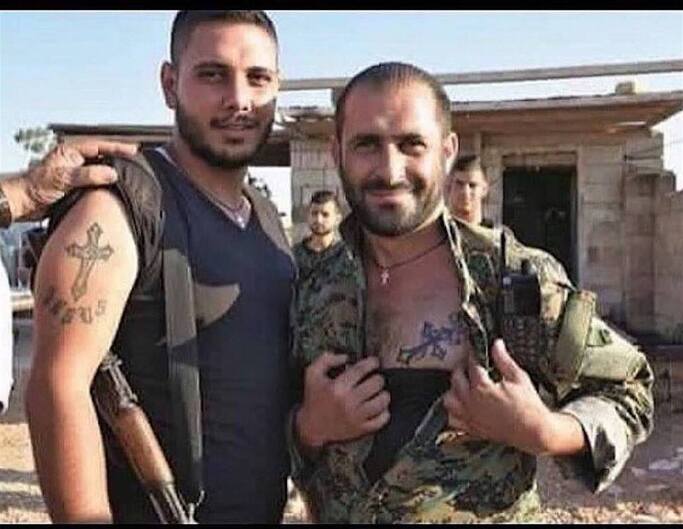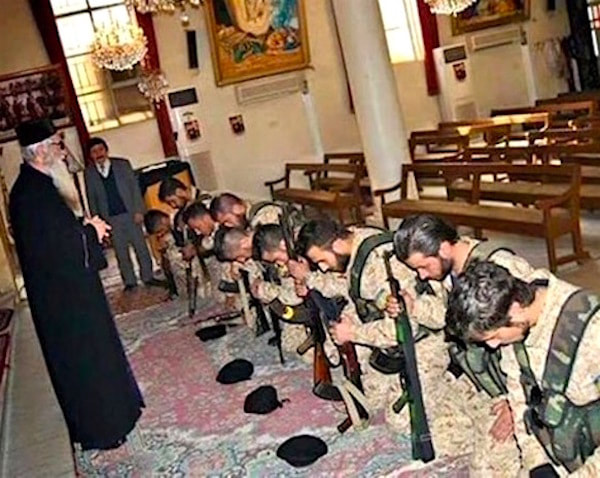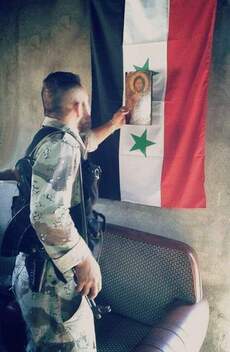SYRIA UPDATE
October 18, 2019
Despite the announcement of Turkey reaching an agreement with the U.S. to ceasefire, Turkish aircraft and artillery shelled residential neighborhoods in Ras al-Ayn. Houses, mosques, churches and monasteries were hit.
Eight civilians were killed and at least 25 were injured.
Intense shelling by Turkish aircraft hit Umm al-Khair village and the Zarkan area of Ras al-Ayn.
According to local sources, groups of Turkish forces infiltrated Ras al-Ayn city and the surrounding villages and attacked the civilian villages of Lazka, Abah, Mraikiz and Bab al-Khair.
Turkish forces and their allies are also launching attacks on a number of villages and towns in the countryside of Hasaka and Raqqa, which resulted in deaths and injury of civilians. Considerable material damage was done to service facilities and vital infrastructure such as power and water plants.
Turkish shelling also targeted the villages of Alyia, al-Suosa, al-Hwaish, al-Assadyia, al-Dardarah, al-Jihfa, Hleiwah, Hameid and Louthi, causing damage to civilian houses and property.
Turkish forces also shelled the Alayia neighborhood of Qamishli, causing damage to civilian houses and property.
Additionally, around 3,500 terrorists moved from their base in Idlib to Latakia. They are a mix of terrorist groups, including al-Qaeda, ISIS and Free Syrian Army (the Free Syrian Army began as an army of Muslim Brotherhood). See: terrorist groups defined.
Most all of these terrorists are from foreign countries (see: at least 80 different countries).
Background Note:
In 2011 and 2012, the Free Syrian Army (Muslim Brotherhood) and al-Qaeda armies targeted regions in Syria with large numbers of Christians and Alewites, often massacring entire villages in order to take immediate territory and set up bases of operation.
Many thousands of Syrians began joining their armed forces at this time and fought back. As the Syrian Army liberated a town from al-Qaeda or Muslim Brotherhood armies, they would train and arm the locals so the locals could defend their own towns, thus enabling the army to move to the next battlefront.
In response, Turkey’s President Erdogan and Saudi Arabian prince bin Salman al-Saud created a coalition army of foreign mercenary fighters with several divisions so it could spread itself throughout Syria, thus spreading the Syrian Army thin. This mercenary army was named Jaish al-Fateh and Turkey began permitting massive numbers of foreign fighters and weapons to enter Syria via the Turkish border.
Idlib, a Syrian city on the border with Turkey, became a city where large masses of terrorists accumulated.
The Syrian government has a long-held policy of allowing terrorists who give up their weapons the opportunity to vacate without harm or arrests. When the Syrian Army recaptures a neighborhood or town from al-Qaeda, ISIS or some other terror group, any terrorists who are willing to give up their weapons and vacate are provided bus transportation to the border at Idlib. It was expected they would vacate back through Turkey.
What evolved over the years was an enormous population of foreign-born terrorists taking up camp in Idlib.
For full details of U.S. involvement in the creation of the original terrorist armies, see: U.S. involvement.
Despite the announcement of Turkey reaching an agreement with the U.S. to ceasefire, Turkish aircraft and artillery shelled residential neighborhoods in Ras al-Ayn. Houses, mosques, churches and monasteries were hit.
Eight civilians were killed and at least 25 were injured.
Intense shelling by Turkish aircraft hit Umm al-Khair village and the Zarkan area of Ras al-Ayn.
According to local sources, groups of Turkish forces infiltrated Ras al-Ayn city and the surrounding villages and attacked the civilian villages of Lazka, Abah, Mraikiz and Bab al-Khair.
Turkish forces and their allies are also launching attacks on a number of villages and towns in the countryside of Hasaka and Raqqa, which resulted in deaths and injury of civilians. Considerable material damage was done to service facilities and vital infrastructure such as power and water plants.
Turkish shelling also targeted the villages of Alyia, al-Suosa, al-Hwaish, al-Assadyia, al-Dardarah, al-Jihfa, Hleiwah, Hameid and Louthi, causing damage to civilian houses and property.
Turkish forces also shelled the Alayia neighborhood of Qamishli, causing damage to civilian houses and property.
Additionally, around 3,500 terrorists moved from their base in Idlib to Latakia. They are a mix of terrorist groups, including al-Qaeda, ISIS and Free Syrian Army (the Free Syrian Army began as an army of Muslim Brotherhood). See: terrorist groups defined.
Most all of these terrorists are from foreign countries (see: at least 80 different countries).
Background Note:
In 2011 and 2012, the Free Syrian Army (Muslim Brotherhood) and al-Qaeda armies targeted regions in Syria with large numbers of Christians and Alewites, often massacring entire villages in order to take immediate territory and set up bases of operation.
Many thousands of Syrians began joining their armed forces at this time and fought back. As the Syrian Army liberated a town from al-Qaeda or Muslim Brotherhood armies, they would train and arm the locals so the locals could defend their own towns, thus enabling the army to move to the next battlefront.
In response, Turkey’s President Erdogan and Saudi Arabian prince bin Salman al-Saud created a coalition army of foreign mercenary fighters with several divisions so it could spread itself throughout Syria, thus spreading the Syrian Army thin. This mercenary army was named Jaish al-Fateh and Turkey began permitting massive numbers of foreign fighters and weapons to enter Syria via the Turkish border.
Idlib, a Syrian city on the border with Turkey, became a city where large masses of terrorists accumulated.
The Syrian government has a long-held policy of allowing terrorists who give up their weapons the opportunity to vacate without harm or arrests. When the Syrian Army recaptures a neighborhood or town from al-Qaeda, ISIS or some other terror group, any terrorists who are willing to give up their weapons and vacate are provided bus transportation to the border at Idlib. It was expected they would vacate back through Turkey.
What evolved over the years was an enormous population of foreign-born terrorists taking up camp in Idlib.
For full details of U.S. involvement in the creation of the original terrorist armies, see: U.S. involvement.
October 17, 2019
Jabhat al-Nusra, which is al-Qaeda's army in Syria, launched 22 attacks in Aleppo, Lattakia, Idlib and Hama provinces. The terrorists attacked residential houses in villages and towns as well as Syrian Army posts.
Jabhat al-Nusra, which is al-Qaeda's army in Syria, launched 22 attacks in Aleppo, Lattakia, Idlib and Hama provinces. The terrorists attacked residential houses in villages and towns as well as Syrian Army posts.
October 15-17, 2019
The Syrian Army deployed into northeastern Syria. This deployment began on October 13, according to the terms of the agreement made with Kurdish-led forces (details below).
The Syrian Army first deployed to several towns in the northwestern countryside of al-Hasakah province and then continued with deployment as per the agreement.
Kurdish-led forces handed over the Kobane border crossing with Turkey and the area surrounding it to the Syrian Army on October 16. This was important because of the large civilian population living in this region who were at risk from being targeted by the Turkish forces and their affiliates.
Note: one of these affiliates is the Muslim Brotherhood based army called the Free Syrian Army (the name is meant to fool you). For details on these terrorist armies, who were called "rebels" and "opposition" during the Obama years, see: Syrian Opposition Groups defined.
October 13, 2019 Agreement made between the Syrian government and the Kurdish-led forces:
Under the agreement, the Syrian Army would move into Kurdish-held territory from three directions:
* From Tabqa towards Ayn Issa and its countryside and towards the Syrian-Turkish border at Tell Abyad and then westward.
* From Manbij towards Ayn al Arab on the Syrian-Turkish border to Tell Abyad and then westward.
* From Hasakah to Ras al-Ayn then heading east to Qamishli and then to al-Malikiyah and heading south.
* The Syrian Army will then spread throughout the Manbij region, starting from Arima.
In the agreement, leaders of the Kurdish-led forces confirmed that they are prepared to preserve the territorial unity of Syria and under Syria's official flag.
The Syrian Army deployed into northeastern Syria. This deployment began on October 13, according to the terms of the agreement made with Kurdish-led forces (details below).
The Syrian Army first deployed to several towns in the northwestern countryside of al-Hasakah province and then continued with deployment as per the agreement.
Kurdish-led forces handed over the Kobane border crossing with Turkey and the area surrounding it to the Syrian Army on October 16. This was important because of the large civilian population living in this region who were at risk from being targeted by the Turkish forces and their affiliates.
Note: one of these affiliates is the Muslim Brotherhood based army called the Free Syrian Army (the name is meant to fool you). For details on these terrorist armies, who were called "rebels" and "opposition" during the Obama years, see: Syrian Opposition Groups defined.
October 13, 2019 Agreement made between the Syrian government and the Kurdish-led forces:
Under the agreement, the Syrian Army would move into Kurdish-held territory from three directions:
* From Tabqa towards Ayn Issa and its countryside and towards the Syrian-Turkish border at Tell Abyad and then westward.
* From Manbij towards Ayn al Arab on the Syrian-Turkish border to Tell Abyad and then westward.
* From Hasakah to Ras al-Ayn then heading east to Qamishli and then to al-Malikiyah and heading south.
* The Syrian Army will then spread throughout the Manbij region, starting from Arima.
In the agreement, leaders of the Kurdish-led forces confirmed that they are prepared to preserve the territorial unity of Syria and under Syria's official flag.
Photos Below: What Western media never told Americans is that Christians are in the Syrian Army and the National Defense Forces. Many are generals. They participated in enormous undertakings to liberate various regions of Syria from ISIS, al-Qaeda and Muslim Brotherhood armies. These heroes are never given credit because Western media is corrupt and on the side of the Islamist armies.
Further Reading to help you understand what happened in Syria
The Syrian Army Fights for Maloula--where the people still speak Aramaic--the language of Jesus)
The Syrian Army Fights for Saidneya--where a giant statue of Jesus can be seen from Lebanon, Jordan and Israel
Facts you need to know about the US-led coalition in Syria
Why did John McCain enter Syria illegally on February 23, 2017?
Why is the U.S. targeting Syrian Forces?
US participated in a $500-million dollar program to train and arm terrorists in Syria
The Syrian Army Fights for Maloula--where the people still speak Aramaic--the language of Jesus)
The Syrian Army Fights for Saidneya--where a giant statue of Jesus can be seen from Lebanon, Jordan and Israel
Facts you need to know about the US-led coalition in Syria
Why did John McCain enter Syria illegally on February 23, 2017?
Why is the U.S. targeting Syrian Forces?
US participated in a $500-million dollar program to train and arm terrorists in Syria


